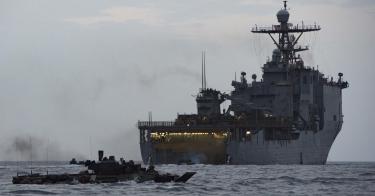Last week, the Chief of Naval Operations and the Commandant of the Marine Corps got into a rare public dispute. The disagreement revolves around the Navy’s decision to drop a planned purchase of a San Antonio-class amphibious warship from its 2024 budget.
While this is about a warship, the impasse arises from a major problem: the Pentagon’s political leaders have thus far failed to articulate a workable long-term vision for naval shipbuilding.
The Defense Department needs to spell out what naval resources are needed to deter China from aggression, not just tell us what they were able to fit under an arbitrary budget cap. In the absence of such a statement, Congress must execute its constitutional duty to “provide and maintain a Navy.” It must substitute its judgment for the missing Pentagon advice.
For too long, political leaders have starved the Navy of predictable shipbuilding resources, leading to priorities and choices that have actually cost the nation more while delivering fewer warships. One consequence of this dysfunction has been a running dispute pitting the Navy against the Marine Corps as both strive to build a force that can defend the nation’s interests.
>>> The U.S. Navy Must Grow To Confront China (but We Must Study Past Sins)
Today we find the Chief of Naval Operations arguing that the rising price of the new amphibious warship is getting too high. On the other side, the Marine Corps Commandant insists the program must continue apace. The Corps’ Force Design 2030, widely recognized as well-founded, relies heavily on the availability of amphibious warships.
Rather than resolve this dispute, the Secretary of Defense has directed a “strategic pause” on amphibious warship procurement for yet another review. This seems unnecessary. A review was just completed just three months ago. Reviews and studies are one way Washington operatives avoid making difficult decisions—and often a way to quietly kill a program.
On the merits, the Commandant seems to have the advantage in this dispute.
The San Antonio warship is a stable design and has not seen significant cost increases in recent years. What cost increases there have been of late do not appear to outpace inflation—and those increases are not on the order of other shipbuilding programs.
The Chief of Naval Operations' argument that there is a 25-percent price increase over the last procurement of a San Antonio-class flight two ship is misleading. In 2019, planning documents anticipated the ship would cost $1.74 billion. But if inflation is accounted for, the price would total $1.95 billion—more than the current procurement cost of $1.9 billion.
If price control is the goal during times of high inflation, then purchasing groups of the ships in a block buy should be pursued—something the Secretary of the Navy, the Chief of Naval Operations, and the Commandant agree should be done. Better yet, do block buys across all stable warship designs for the greatest savings and predictability of orders—something our shipyards need to drive prices down anyway.
But the larger issue is that, despite the growing China threat, the Biden administration’s budgets have consistently underfunded defense, even as they proposed double-digit percentage increases to other federal departments with little or no justification (see Table S-8 on p. 164).
>>> For the Larger Navy U.S. Needs, American Shipping and Shipbuilding Must Be Revived
The unfortunate pawns in this game are the Commandant and the Chief of Naval Operations. Both are desperately trying to fashion a warfighting force out of an inadequate shipbuilding budget.
In yet another example of this lack of a strategic vision, the Secretary of the Navy recently indicated that, once again, he intends to submit three long-range shipbuilding options to Congress instead of one. The Constitution designates the president as the Commander in Chief to make the difficult recommendations regarding the nation’s defense. But in this case—rather than take a stand for the naval force the nation needs—the administration intends to punt the decision to Congress. This lack of leadership makes shipbuilding more uncertain and continues a downward spiral of Navy capacity.
Last December, congressional frustration with trying to discern the Navy’s shifting shipbuilding priorities led lawmakers to form a commission on the future of the Navy. Given the recent kerfuffle over amphibious warship procurement, an external review of the Navy’s force structure is needed.
Congress will probably need to once again overrule the president’s budget on defense. In the short term, this would mean sticking to past plans and buying this warship. But in the long run, what is vitally needed is leadership from this administration to lay out a workable vision for securing the nation and building the Navy the nation needs.
This piece originally appeared in DefenseOne




